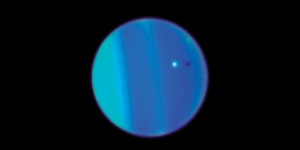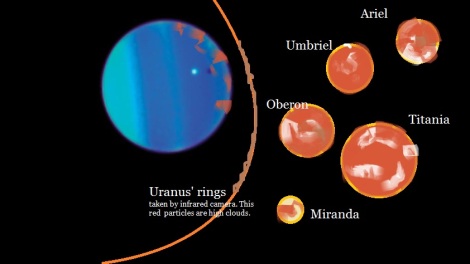 URANUS is the 7th planet from the SUN. Uranus is 1,783 million miles average distance from the SUN. It was discovered in the late 18th century and it orbits the sun in a circular motion. It takes Uranus 84 years to orbit the Sun and 17.9 hours to rotate on its axis. Uranus was discovered by a British Astronomer William Herschel in 1781.
URANUS is the 7th planet from the SUN. Uranus is 1,783 million miles average distance from the SUN. It was discovered in the late 18th century and it orbits the sun in a circular motion. It takes Uranus 84 years to orbit the Sun and 17.9 hours to rotate on its axis. Uranus was discovered by a British Astronomer William Herschel in 1781.
Uranus is presume to have 21 moons, for many years it was thought to have had 15 moons and they may be many more to be discovered. The five largest moons of Uranus are Ariel, Umbriel of which are both dark and cratered, while Titania consists of deep dark long valleys, Oberon is heavily cratered and Miranda is a small ball of ice, about 293 miles in diameter which was presumed to have been traverse by a comet in the early 17th centuries.
It is believed that William Herschel made several appearance to William Shakespeare and Alexander Pope naming some of Uranus’ moons after characters.
Uranus consist of metalloids and metallic surfaces which may have been created from combination of freezing liquids and solids many many years ago.
In 1986, it was discovered that Uranus consist of ring layers mostly made of dark dust which was probed by voyager 2.
Uranus was officially discovered by Sir William Herschel in 1781
It is too dim to have been seen by the ancients. At first Herschel thought it was a comet, but several years later it was confirmed as a planet. Herschel tried to have his discovery named “Georgian Sidus” after King George III. The name Uranus was suggested by astronomer Johann Bode. The name comes from the ancient Greek deity Ouranos.
Uranus is often referred to as an “ice giant” planet just like the other gas giants, it has a hydrogen upper layer, which has helium mixed in. Below that is an icy “mantle, which surrounds a rock and ice core. The upper atmosphere is made of water, ammonia and the methane ice crystals that give the planet its pale blue color. Uranus is one of the Coldest Planet with minimum atmospheric temperature of -197°C Uranus is the coldest planet in the solar system. The upper atmosphere of Uranus is covered by a methane haze. This hides the storms that take place in the cloud decks.

Uranus has two sets of thin rings of which are dark color made of small particles, ranging from a dust-sized particles to small boulders. There are 9 inner rings and 2 outer rings. They probably formed when one or more of Uranus’s moons were broken due to comet colliding one another. The first set of rings was discovered in 1977 and the second set was discovered in 2003 by the Hubble Space Telescope.
It is denoted that only one spacecraft has flown by Uranus. In 1986, the Voyager 2 spacecraft swept past the planet at a distance of 81,500 km. It returned the first close-up images of the planet, its moons, and rings.